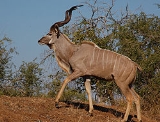
Greater Kudu
Overview
The Greater Kudu is a woodland
antelope
found throughout eastern
and southern
Africa
. Despite occupying such widespread territory
, they are sparsely populated in most areas, due to a declining habitat
, deforestation
and hunting
.
Greater Kudus have a narrow body
with long leg
s, and their coat
s can range from brown/bluish-grey to reddish-brown. They possess between 4–12 vertical white stripes along their torso
. The head
tends to be darker in colour than the rest of the body, and exhibits a small white chevron which runs between the eyes.
Male Greater Kudus tend to be much larger than the females, and vocalize much more, utilizing low grunts, clucks, humming, and gasping.
Woodland
Ecologically, a woodland is a low-density forest forming open habitats with plenty of sunlight and limited shade. Woodlands may support an understory of shrubs and herbaceous plants including grasses. Woodland may form a transition to shrubland under drier conditions or during early stages of...
antelope
Antelope
Antelope is a term referring to many even-toed ungulate species indigenous to various regions in Africa and Eurasia. Antelopes comprise a miscellaneous group within the family Bovidae, encompassing those old-world species that are neither cattle, sheep, buffalo, bison, nor goats...
found throughout eastern
East Africa
East Africa or Eastern Africa is the easterly region of the African continent, variably defined by geography or geopolitics. In the UN scheme of geographic regions, 19 territories constitute Eastern Africa:...
and southern
Southern Africa
Southern Africa is the southernmost region of the African continent, variably defined by geography or geopolitics. Within the region are numerous territories, including the Republic of South Africa ; nowadays, the simpler term South Africa is generally reserved for the country in English.-UN...
Africa
Africa
Africa is the world's second largest and second most populous continent, after Asia. At about 30.2 million km² including adjacent islands, it covers 6% of the Earth's total surface area and 20.4% of the total land area...
. Despite occupying such widespread territory
Territory (animal)
In ethology the term territory refers to any sociographical area that an animal of a particular species consistently defends against conspecifics...
, they are sparsely populated in most areas, due to a declining habitat
Habitat
* Habitat , a place where a species lives and grows*Human habitat, a place where humans live, work or play** Space habitat, a space station intended as a permanent settlement...
, deforestation
Deforestation
Deforestation is the removal of a forest or stand of trees where the land is thereafter converted to a nonforest use. Examples of deforestation include conversion of forestland to farms, ranches, or urban use....
and hunting
Hunting
Hunting is the practice of pursuing any living thing, usually wildlife, for food, recreation, or trade. In present-day use, the term refers to lawful hunting, as distinguished from poaching, which is the killing, trapping or capture of the hunted species contrary to applicable law...
.
Greater Kudus have a narrow body
Body
With regard to living things, a body is the physical body of an individual. "Body" often is used in connection with appearance, health issues and death...
with long leg
Leg
Łęg may refer to the following places in Poland:*A former name for the town of Ełk *Part of the Czyżyny district of Kraków*Łęg, Pleszew County in Greater Poland Voivodeship...
s, and their coat
Coat (animal)
Coat, or the nature and quality of a show mammal's pelage, is important to the animal fancy in the judging of the animal, particularly at conformation dog shows, cat shows and horse shows...
s can range from brown/bluish-grey to reddish-brown. They possess between 4–12 vertical white stripes along their torso
Torso
Trunk or torso is an anatomical term for the central part of the many animal bodies from which extend the neck and limbs. The trunk includes the thorax and abdomen.-Major organs:...
. The head
Head
In anatomy, the head of an animal is the rostral part that usually comprises the brain, eyes, ears, nose and mouth . Some very simple animals may not have a head, but many bilaterally symmetric forms do....
tends to be darker in colour than the rest of the body, and exhibits a small white chevron which runs between the eyes.
Male Greater Kudus tend to be much larger than the females, and vocalize much more, utilizing low grunts, clucks, humming, and gasping.
Unanswered Questions

